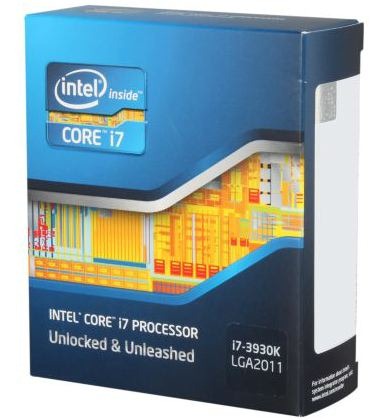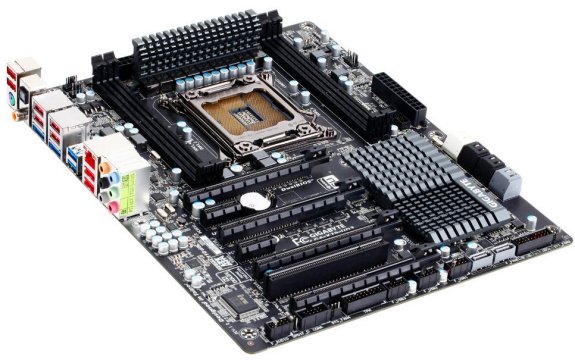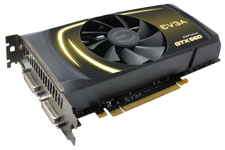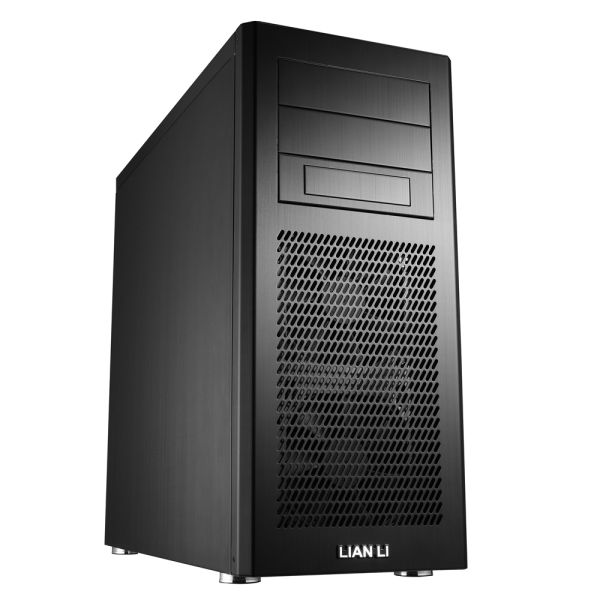Holiday 2011 Mainstream High-End Buyer's Guide
by Zach Throckmorton on December 9, 2011 12:00 AM EST- Posted in
- Guides
- AMD
- Intel
- Sandy Bridge
- CrossFire
- Sandy Bridge E
- Holiday 2011
- NVIDIA
Productivity powerhouse

Intel's Sandy Bridge-E CPU architecture recently launched in the form of two SKUs: the $1000 Core i7-3960X and the $600 Core i7-3930K. These chips differ ever so slightly in that the 3960X has 15MB L3 cache compared to the 3930K's 12MB L3 cache, and the 3960X's stock and Turbo clockspeeds are 100MHz higher than the 3930K's. That is, $400 clearly represents very diminishing returns. Anand reviewed the 3960X recently and found that compared to the Core i7-2600K, the 3960X won in single-threaded performance by a very narrow margin. By extrapolation, the 3930K recommended for this productivity PC will perform very similarly to the 2600K in single-threaded applications. However, because of the SNB-E chips' extra two cores compared to the 2600K, their multi-threaded performance advantage is, as Anand put it, "staggering."
You can see how the 3960X fares against the 2600K on Bench—and recognize that the 3930K we're recommending here will perform ever so slightly slower than the 3960X (unless you choose to overclock). It is critical to understand the nature of your workflow—are you using heavily multi-threaded applications or not? If you are, will your workflow performance improve enough using a 3930K over a 2600K to justify the extra $300 or so cost? If the answer to both of these questions is "yes", then this computer is designed for you. Because neither SNB-E CPU comes with a cooler, we're once again going with Corsair's H80 water-cooling kit.

Intel's SNB-E CPUs use a new socket, LGA 2011. Gigabyte's GA-X79-UD3 is an ATX form factor motherboard that represents a good value amongst X79 chipset boards. If your applications benefit from GPU acceleration, it has two PCIe x16 and two PCIe x8 lanes, though of course filling those lanes will push the cost of the build from just over $2000 to much higher depending on what GPUs you buy.
SNB-E supports quad channel memory, and the GA-X79-UD3 has four DIMM slots. The board's max memory support is 32GB, though we're going with 16GB total here for cost reasons. Again, springing for four 8GB modules might or might not be worth the additional investment; you'll have to make that decision based on your particular needs.
One of the drawbacks with SNB-E compared to SNB is that there's no integrated graphics at all, so you need to buy some form of GPU even if you don't plan on playing any games. Then again, for professional video work you'd almost certainly want a decent GPU regardless. Given we're looking at the high-end of the market and recommending a $1000  platform, we're going to give our primary recommendation to NVIDIA's GTX 560, which has slightly less CUDA cores and lower clocks than the GTX 560 Ti but still represents a fairly healthy upgrade from the GTX 550 Ti. We're going with NVIDIA here as we've had reasonably good experiences using their GPUs in Adobe Premiere, though you can just as easily go with an AMD Radeon HD 6850--and the two GPUs would trade blows in gaming benchmarks.
platform, we're going to give our primary recommendation to NVIDIA's GTX 560, which has slightly less CUDA cores and lower clocks than the GTX 560 Ti but still represents a fairly healthy upgrade from the GTX 550 Ti. We're going with NVIDIA here as we've had reasonably good experiences using their GPUs in Adobe Premiere, though you can just as easily go with an AMD Radeon HD 6850--and the two GPUs would trade blows in gaming benchmarks.
If you feel the GTX 560 is overkill for what you plan on doing, our alternate recommendation is AMD's Radeon HD 6670, which costs about half as much but only has one third the performance potential. Our NVIDIA alternative at the low end would be the GT 440 GDDR5, which costs a bit more than the HD 6670 but should also have a bit better performance. On the other hand, if you're really doing professional work, you'd probably want a workstation level OpenGL card. Never mind that most workstation users buy prebuilt systems--we've covered that market already. For a DIY workstation, you could easily double the cost of what we're putting together by adding a high-end Professional card. In that case, you probably know better than us whether you'd like a Quadro 5000/6000 or a FirePro V8800/V9800, so we'll leave the choice to you.
Because a $2000 PC without an SSD is a travesty, we're recommending Crucial's M4 128GB again, a reliable, relatively speedy SSD with lots of space for your OS and productivity applications with large installation sizes. Many workflows (such as intensive Photoshop usage) benefit from a fast scratch disk, so we're also including a Samsung F3 1TB. Finally, to round out the storage, we have a capacious 3TB Hitachi Deskstar for mass storage. At the risk of sounding repetitive, be  sure you understand your workflow before dropping hundreds of dollars on storage configurations you might not really need. As noted in the HTPC build, you might also want to hold off on the third storage drive until HDD prices drop.
sure you understand your workflow before dropping hundreds of dollars on storage configurations you might not really need. As noted in the HTPC build, you might also want to hold off on the third storage drive until HDD prices drop.
Though this PC is extremely powerful, it is not especially power-hungry. A productivity computer should be, above all else, reliable, and for this reason SeaSonic's SS-560KM power supply gets our recommendation. This is a highly efficient PSU and in my experience, it's very quiet and supplies components with very clean power. Work PCs are often conservative in their looks, but Lian-Li's PC9F looks very sharp while looking modest. It's also a great case in terms of its thermals and acoustics.
| Component | Product | Price |
| CPU | Intel Core i7-3930K | $600 |
| CPU cooler | Corsair H80 | $94 |
| Motherboard | Gigabyte GA-X79-UD3 ATX | $270 |
| RAM | (2) Crucial 8GB (2x4GB) DDR3 1333 | $80 (total) |
| GPU | EVGA GeForce GTX 560 | $180 ($15 MIR) |
| GPU (Alternate) | Sapphire Radeon HD 6670 | $80 ($15 MIR) |
| SSD | Crucial M4 128GB | $210 |
| HDD | Samsung Spinpoint F3 1TB | $150 |
| HDD | Hitachi Deskstar 3TB | $260 |
| PSU | SeaSonic SS-560KM 560W | $135 |
| Case | Lian-Li PC9F | $120 |
| Optical drive | ASUS DRW-24B1ST/BLK/B/AS | $19 |
| Operating system | Microsoft Windows 7 Professional | $130 |
| Total: | $2248 | |
We have a few concluding remarks on the next page.










52 Comments
View All Comments
piroroadkill - Friday, December 9, 2011 - link
Mine's pretty similar :3i5-2500K
Asus P8Z68-V Pro
Corsair A70
Seasonic X-660
Fractal Design Define R3
8GB Patriot G2
Also, MSI Twin Frozr III Radeon 6950 (which unlocked to 1536 shaders)
87_heavyboy - Friday, December 9, 2011 - link
The ASRock Z68M-ITX/HT looks nice at first glance, so I bought it, too. Together with the i7 2600K. I also thought "great, m-ITX + overclocking - something for the future". In practice, it has its problems. The mosfets don't have coolers on them, they get hot quite fast, resulting in throttling. The board can't hold 3.4 GHz for some minutes during compilation :( I did not even think about overclocking!The other problem: It supports Overclocking but no undervolting. SNB comes with quite defensive default-voltage, resulting in good undervolting-potential.
Positive:
It pulls just ~30W at idle.
I think, it would have been a better choice to go mATX, if it should be a smaller PC.
duploxxx - Friday, December 9, 2011 - link
this HTPC design is a huge waste of moneyMrTeal - Friday, December 9, 2011 - link
I was curious about that too.My HTPC is a low power, quiet affair with an X3, a modded and silent 5570 and an SSD, no mechanical HDD. Any encoding I do on my main rig so that my HTPC stays low power and silent, and just stream the data over the network.
Do many people really build powerful and expensive HTPCs? I find usingmine as a PC @ 1080p/47" is kind of a poor experience when you're sitting at normal TV viewing distances, so all I really use mine for is a media streamer and checking scores / watching Youtube. Any real computing I just do at my desktop. I'd be interested in how other people use these HTPCs.
Z Throckmorton - Friday, December 9, 2011 - link
Generally speaking, an AMD E-350 setup is sufficient for the majority of HTPC usage scenarios. However, I have built a few more powerful HTPCs for people who want to transcode video but don't want their primary home computer tasked as a video editor, and don't want to bother with a LAN.Death666Angel - Friday, December 9, 2011 - link
That is bollocks. They clearly state they are not going with a traditional HTPC setup (i.e. just be able to play back everything). They want performance for coding, HDTV streaming capabilities and storage as well. If people are in the market for that and have the cash, there is nothing I would really see being done to bring down the price while maintaining the performance.I personally have a small media client and a large file server in the back and I'm not interested in HDTV stuff. I came away spending about 400€.
piroroadkill - Friday, December 9, 2011 - link
I wouldn't recommend them, anymore. I've seen my 2GB Radeon 6950 use more than 1GB with GPU-Z open on another screen. For the slight extra cost, and the chance of unlocking (mine did, and it's not so old), 2GB 6950 all the way, all the time.prdola0 - Friday, December 9, 2011 - link
Zach, wouldn't it be better to use 2x non-reference GTX560Ti in SLI instead of 2x HD6950? There is quite a lot of GTX560Ti models clocked ~15% higher than the reference card, which matches even the HD6970 performance. They are both more price-efficient than HD6950 and also SLI tends to be more stable (you usually don't see negative scaling and similar problems). Of course there is also the added value of Nvidia actually supporting gamers, unlike AMD. The Skyrim graphics setup guide they just recently released is simply great and most other GeForce.com articles are helpful just as much.Take care,
Prdola
Death666Angel - Friday, December 9, 2011 - link
Hm....According to the bench, SLI 560TI and CF HD6950 trade blows the whole time except for Civ5 where nVidia clearly wins or anything above 1920x1200 where AMD clearly wins.
If you go with SLI/CF, gaming at 1920x1200 is moronic anyway, so I think it is very valid to recommend HD6950 over the 560TI. Also, most recent reviews of CF/SLI I have seen have them nearly on par, with nVidia leading in a few games and AMD in others. It is not a situation like two years ago where nVidia had a clear lead. And speaking for my market, there really is no difference between HD6950 and 560TI cards. You can find both at pretty much the same price points.
So, to summarize: to each his own, every company has great cards for good prices. Look at your usage pattern and a special deal, then decide. :-)
prdola0 - Monday, December 12, 2011 - link
That's hardly so. I am talking about overclocked editions of GTX560Ti. In this regard the GTX560Ti is almost as easily over-clockable as GTX460 was. And there are almost as many 560Ti non-reference OC models. And those editions trade blows with HD6970, yet are priced at HD6950 mark or some between HD6950 and HD6970.